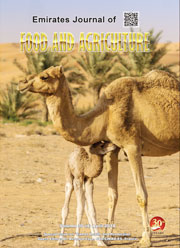Cis-vaccinic acid, Dibutyl-Cyanamide and 9, 12-Octadecadienoic acid from pistachio (Pistachia vera) seed coat (PSCE) induced nuclear damage and cytotoxicity in human colon cancer HT-115 cells
DOI:
https://doi.org/10.9755/ejfa.2023.3163Abstract
Current strategy for colorectal cancer (CRC) therapy like regular intake of non-steroidal anti-inflammatory drugs (NSAIDs) may reduce the risk of developing CRC but they induce the regression of adenomas. Even the CRC management technique include colectomy, have not yet been proven to reduce mortality. The present study aimed to reduce the susceptibility of CRC via controlling cellular oxidative stress, inflammation and caspase depended apoptosis in HT-115 human colorectal cancer cells using pistachio seed coat extract as nutritional therapy. Increasing concentrations of pistachio seed coat ethyl acetate extract (PSCE) were applied to HT-115 cells, which were incubated for 24 h and 48 h. The IC50 values were 14 mg/dl after 24 h, and and 7.5 mg/dl after 48 h. Acridine orange/ ethidium bromide staining confirmed the presence of 32% early apoptotic, 27% pre-apoptotic, 12% apoptotic, and 6% necrotic cells after 48 h. PSCE at 14 mg/dl significantly increased the antioxidant capacity via the expression of CYP1A and GSK3β, and decreased inflammatory agents via decreasing NF-κb, TNF-α, COX-2 and PGE-2 expression three-fold after 48 h. The expression of the tumor suppression related genes p53 and mdm2, and the apoptosis related genes Bax, Bcl-2, Caspase 3, p21, and PCNA levels increased one-fold, and levels of mdm2, Bcl-2 and PCNA decreased after PME treatment of 48 h. PSCE effectively controlled colon cancer cell proliferation via the caspase-dependent mitochondrial mediated apoptotic pathway.
Keywords: Pistachia vera, cytotoxicity, human colon cancer, Cis-Vaccininc acid, apoptosis
Downloads
Published
How to Cite
Issue
Section
Copyright (c) 2023 Mohammed Saeed Alkaltham, Pandurangan Subash-Babu, Ahmad Mohammad Salamatullah, Ghalia Shamlan, Laila Al-Harbi, Ali A Alshatwi

This work is licensed under a Creative Commons Attribution-NonCommercial 4.0 International License.










 .
. 